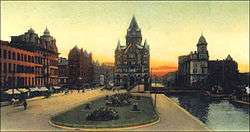Clinton Square
| Clinton Square | |
|---|---|
|
Clinton Square next to the Erie Canal in 1906 | |
| Location | Syracuse, New York |
| Coordinates | 43°3′3″N 76°9′10″W / 43.05083°N 76.15278°WCoordinates: 43°3′3″N 76°9′10″W / 43.05083°N 76.15278°W |
| Area | .553 acres (0.00224 km2) |
| Governing body | City of Syracuse |
 Location of Clinton Square in the US | |
Clinton Square, in downtown Syracuse, New York, was the original town center and first came into existence in the early 19th century where roadways from north and south convened. By 1825, the construction of the Erie Canal further transformed the busy intersection into the center of commerce and trade in Central New York.[1]
The canal was filled in during 1925 and was converted to Erie Boulevard, a major thoroughfare that runs east to west through the city.[2] Today the square is a popular location for outdoor events and festivals in the city and is located on Erie Boulevard West and North Salina Street in downtown Syracuse.[1]
History
Clinton Square is the historic center of downtown Syracuse, New York and was named in honor of 19th century politician, DeWitt Clinton who served two terms as Governor of New York State. During his tenure, Clinton was instrumental in the construction of the Erie Canal which ran through the center of the square.[3]
The small park is bounded by West Genesee Street on the north, East Water Street to the south, South Salina Street on the east and South Clinton Street on the west. Erie Boulevard East meets Erie Boulevard West at the square; however, in 2001 traffic was rerouted around the park for the ice rink and reflecting pool.[3]
Early years
The small square played a factor and influenced the formation of the "modern city" and was home to the first daily newspaper, first railroad, first business, first post office, first road, first water communication, first electric light, first automobile, first telephone, first market and first hotel.[4]
It was the "marketing facilities" which made the square the nucleus of the city. In the early days the area was wooded, then cleared and bordered by a few buildings including the home of city founder, Joshua Forman, which was set back from Salina and Water streets "amid lawns and gardens" south of the square. Frame and brick buildings soon "crowded out" the early structures and brick buildings "coated with a yellow finish resembling whitewash" dominated the square.[4]
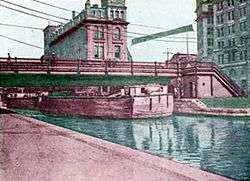
Erie Canal
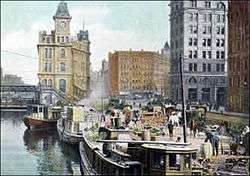
Excavation began on the Onondaga County stretch of the canal in 1817 and was completed in 1825.[2] In the early days, the canal was known as Clinton's Ditch and it split the square in half.[3] The square was the heart of Downtown Syracuse. Its role as the city's business center grew after the Erie Canal was completed.[3]
Besides being the city's main marketplace, the square also served as a dock for canal boats.[2] The packet docks were used by small companies who did not have their own dock to ship and receive goods and supplies. Packet boats made scheduled runs up and down the Erie Canal to various destinations between Albany and Buffalo.[5]
In the beginning, trappers and traders were among those who used the packet dock located in the square. By 1830, nearly five years after the canal opened, deer still ran through the village and bear were shot in Salina Street. A 20-pound salmon was caught in Furnace Brook. Pelts were traded or sold and wild animals were offered for sale to packet boat travelers. Canal life was "wild," with brawling at the locks and at licensed places where drink was cheap and plentiful.[4]
Wood marketing flourished in the city and the forest was cleared to supply fuel for local salt boiling, lumber for new homes and boat building. The pepperidge (Nyssa sylvatica) (also known as tupelo) tree, adapted for "brine-pipe" use in the salt industry were so valuable and in such high demand, the tree is now virtually extinct within a radius of 10 miles (16 km) of the city.[4]

For decades, the square's central location made it the city's social and commercial hub, "a busy spot where boats loaded with wares for the growing city docked and people gathered."[2] By 1905, an elevated "hoist" bridge crossed the canal at Salina Street and Clinton Street. Spectators often stood atop the bridge to watch the barges pass. The bridge could be crossed by pedestrians even when elevated.[5] The new bridge was constructed to replace earlier "swing and arch" bridges.[2]
Town market
The land became an "unofficial" common and was occupied by many squatter marketing interests. Farmers parked their wagons in the streets leading out of the north side of the square. For 50 years or more, scales set up in front of a saloon served as the market scales. In 1877, mayor, James J. Belden named John Connor as city weighmaster and meat inspector, a position he served for 15 years until 1892. Mayor Jacob Amos created two positions and "separated the offices" and Connor was succeeded by Jerry McQuirk whose daughter assisted by Thomas Timmons served as "weighmistress."[4]
Mayor James K. McGuire decided the square should be a park and that the market should be moved to Gifford Street near West Onondaga Street, however, the market dealers and customers were not in favor of his proposal. The Common Council, nevertheless, declared the square formally a park on January 10, 1893. The old "hay market" at North Salina Street, Pearl Street and Belden Avenue became the new city market. In January 1940, a "convenience market" was still located on North Salina Street in the city's Northside.[4]
The last market in the square was conducted on May 15, 1899. Ten years later, on May 30, 1909, the cornerstone for the Soldiers and Sailors Monument was laid.[4]
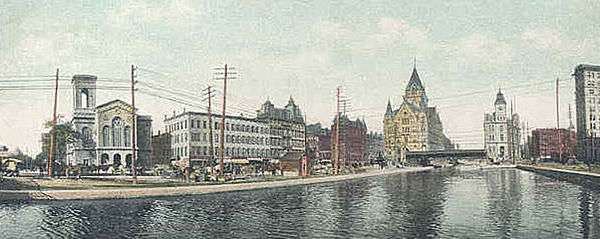
Commercial center
Passenger boats docked along the city's main thoroughfare and packet boats and barges transported cargo through the center of the city. The square was surrounded by the county courthouse, banks, hotels and theaters and made the area the center of city government as well as local commerce.[6]
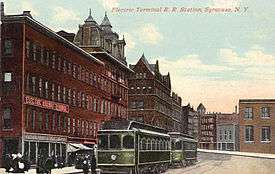
In 1862, there were two steam packet lines "during the season of navigation" that departed from the "basin" in Clinton Square. The first departed each day at 3:30pm with the exception of Sunday. The proprietor was Smith and Drury. The second packet departed each Wednesday and Friday at 5:00am under the direction of captain E. Wheeler.[7]
By the end of the 19th century the canal was no longer in use as a main channel in trade and was later replaced by the New York State Barge Canal which was completed in 1918. For a short period in 1900 there was even discussion of a ship canal. The packet dock on the south side of the square was in use for many years as an "excursion boat quay."[4]
Empire house
The Empire House was a large hotel that was erected on the north side of the square in the mid-19th century. A fire destroyed the hotel in 1942. The Atlantic Building, a two-story art moderne commercial structure was located on the site until 1968. The building was replaced by the Syracuse Newspapers in 1971.[5]
County courthouse
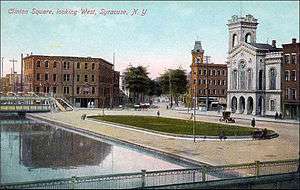
The first courthouse in the area, built in the 1805, was located in Onondaga Hill, New York until the county seat was moved to Syracuse in 1830. Both Onondaga Hill and Salina were contenders for the new facility. Governor DeWitt Clinton vetoed a bill designed to keep the courthouse at Onondaga Hill in an attempt to make Syracuse the Central City, an early nickname for the municipality.[4]
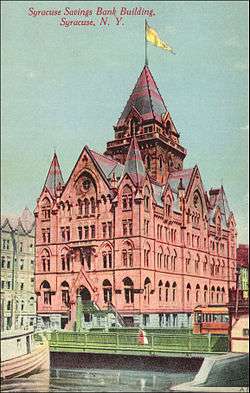
As a compromise, the new courthouse building was placed midway between Syracuse and Salina on North Salina Street, north of Ash Street. The "halfway" courthouse burned in the mid-1850s.[4]
During 1856, architect, Horatio Nelson White was given the "prestigious opportunity" of designing the third Onondaga County Courthouse. At that time, the courthouse was relocated to Clinton Square.[8]
In 1890 the County Board of Supervisors voted to build a new courthouse, the fourth, to replace the constrained quarters of the old courthouse in Clinton Square, however, it wasn't until 12 years later, in 1902, that architects Archimedes Russell and Melvin King were hired to design the new structure which was completed in 1907. The new facility was relocated to St. Mary's Circle, later renamed to Columbus Circle.[9]
City Hall
The original City Hall, commonly known as Market Hall, was located in Clinton Square and was built in 1853. The present Syracuse City Hall was constructed between 1889 to 1893 and the center of city government moved to East Washington and Montgomery streets, a distance of 1 mile (1.6 km).[4]
Gridley building
In 1867, the Gridley Building was constructed to house the Onondaga County Savings Bank. It was designed by architect Horatio Nelson White who designed several buildings in Syracuse.
The building was composed of two sections that were constructed several years apart. The original wing was "wedge shaped" and faced Clinton Square and had a "raised" South Salina Street entrance with "broad" stone steps. The entrance was sealed in the 1960s and the steps were removed. The second addition, a rectangular shaped wing to the east, was added in 1876.
Syracuse Savings bank
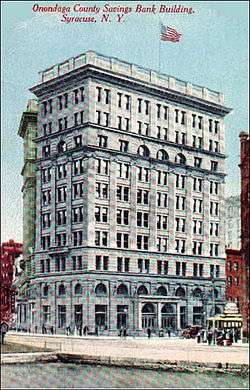
The Syracuse Savings Bank Building was constructed in 1876 and was the first building in the city with a passenger elevator. The architect, Joseph Lyman Silsbee, maintained his office on the top floor surrounded by balconies. The bank was in operation from 1849 until 1987 when it merged with Fleet/Norstar Financial Group who later changed their name to Fleet Bank. Most recently, the bank was purchased by Bank of America.[5]
Onondaga County Savings bank
By 1897, the Onondaga County Savings Bank moved into a new, larger building across Hanover Square in Neo-Classical design which became the main branch.[5] The building, erected in 1896 and designed by architect R. W. Gibson, is still in existence today and called the Onondaga Savings Bank and is located at 113 South Salina Street. It was 9½ stories and constructed of granite and limestone. At that time, the building was the tallest in Syracuse. Angelo Magnanti designed the plaster ceiling and William Teff Schwartz created murals of Onondaga County history.
Townsend block
The Jerry Rescue Monument, which commemorates the rescue of a fugitive slave by citizens in 1851, is located on the western side of the square.[3] The Clinton Square building from which the slave was rescued was called the Townsend Block and after the rescue was commonly known as the "Jerry Rescue Building". The site retained that name even after the original building burned down and a new building was constructed in its place.[2]
Wieting Opera House
The Wieting Opera House was donated in the mid-19th century by physician and medical lecturer, John M. Wieting M.D. (1817–1888)[10] and was considered a "world class" cultural institution.[5] Originally, a building called Wieting Hall, which was a lecture hall, was built at 100 West Water Street[11] at the corner of South Salina Street in 1852 and was lost to fire in 1856.[12]
The building was rebuilt and reopened in 1870 as the Wieting Opera House and had a seating capacity of 1,017.[13] The first opera that took place in the house, however, did not occur until 1886 when the American Opera Company made a brief appearance.[13] In fact, opera was never intended as the main venue in the theater. At that time, towns throughout America had opera houses where operas were seldom or never performed. The "opera house" designation simply provided a respectable cover for places that presented a variety of popular entertainments. Often they were called "museums."[13]
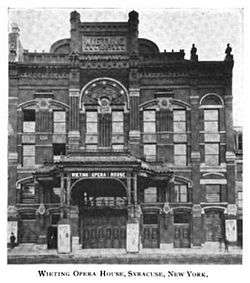
On July 19, 1881, the building was totally destroyed by a fire during early morning hours. The theater was one of the finest in Syracuse and one of the handsomest in New York State. It was wholly destroyed within two hours. The fire was the most "disastrous" that had occurred in the city in 30 years, however, two other minor fires had occurred at that same site during the previous 25 years.[14]
The total loss was $398,000, of which $270,000 was covered by insurance. The building was occupied by 50 tenants and "all are losers to considerable amounts." The tenants owned a variety of businesses in the building including; insurance agencies, clothiers, hardware, boots and shoes, jewelry, agricultural implements and office fixtures. Several professionals such as architects, lawyers, photographers and stock brokers also lost their businesses.[14]
The building was four stories tall and covered half an acre of ground and was still owned by John M. Wieting. The theater was valued at $200,000 and was insured for $80,000. Half a dozen people were severely injured in the fire by the falling walls and debris. The western circuits of the Western Union telegraph lines were interrupted for several hours, and the American Union lines were down in all directions. Intense heat from the fire broke the plate-glass windows in the buildings on the opposite side of the street and did other damage.[14]
The building was quickly rebuilt and opened its doors as a theater in 1882 and had a seating capacity of over 1,200.[12] In 1896, several buildings in Clinton Square burned including the Wieting Building, on the south side of the square which also caught fire in 1856 and 1881 and was rebuilt each time.[2]
By 1897, Wieting's widow had replaced the building. The third Wieting building which seated 2,140, was a "resplendent edifice" with ornate chandeliers, a floor of Italian mosaic tile, marble walls, a rich gold and rose color scheme, draperies of silk and velvet and bronze doors. "In short, a theatre rather than a lecture hall, museum or opera house" as opposed to the original buildings on the site.[13]
During its prime in the late 19th century, world premieres and test runs of plays and light operas were held in the theater.[15]

By the late 1890s, the three theatres in Downtown Syracuse each had their own specialty. The Wieting Opera House became the house of stars in "touring combinations" while the Grand evolved into a vaudeville house and the Bastable, also in Clinton Square, featured stock companies and melodramas and was called the "house of 10-20-30 cent shows." At one point, the Shubert brothers managed all three facilities.[13]
Today the side is occupied by the Atrium, a hotel and office-convention center.[12]
Public library
The public library, called the Franklin Institute, conducted its activities in the Wieting Block and sponsored "lecture courses and book circulation."[4]
Bastable block
By 1893, the Wieting and Grand theatres were making so much money in the city that Frederick Bastable built a third and called it the Bastable. The theatre did not become profitable until December 1897, when local magnate, Sam Shubert took over the management.[13]
The Bastable theatre "abandoned" the horseshoe-style configuration that had been traditional in theatres in the 1880s. It had two balconies and three decorated "boxes" on each side of the house. In the early days, the gallery cost 10 cents, the balcony cost 20 cents and the orchestra was 30 cents.[13]
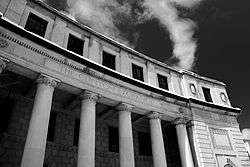
Main post office
The Federal Building and former main Post Office which is now called Clinton Exchange was constructed in 1928 in a Neoclassical architecture style and is located at the western end of Clinton Square.[16]
Soldiers' and Sailors' Monument
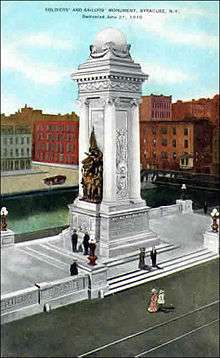
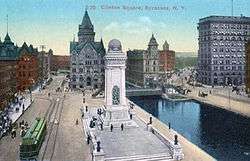
Planning for the Soldiers' and Sailors' Monument which was donated by Charles M. Warner, began in 1894 when the project was first approved. Initially, plans were made to erect the monument in Hanover Square but Warner felt the area was too small for such a large monument. By March 1896, the Common Council approved of Clinton Square as the location with the exception of Alderman Matty who wanted to keep the produce market. According to the council; "the most feasible solution of the market question appears to be the removal of the produce market to the location of the present hay market and the removal of the hay market to another location."[17]
The grassy oval in the center of the square was removed in 1909 for the addition of the Soldiers' and Sailors' Monument which was erected in honor of 12,000 Onondaga County Civil War veterans.[1] The building was designed by architect by Cyrus Edwin Dallin, a noted sculptor, at a cost of $79,000. Theodore E. Hancock sponsored the county bonding for the purpose.[4] Many residents observed the dedication of the monument in June 1910, from the roofs and windows of nearby buildings after the street became too crowded.[2]
The canal was in use until the early 1920s. During 1925, the Erie Canal was filled in and the southside of the square became a parking lot and soon became a major transportation hub with the addition of Erie Boulevard which ran from east to west through the city.[2]
In the late 1950s, the monument and statues required a "powerful cleaning" and recently the statues were shipped to Maryland for another cleaning.[2]
Renovations
Clinton Square was renovated several times throughout the years. After the swampland of Syracuse was paved over, landscapers tried to recreate a "natural feel in an urban setting," however, the vegetation did not last very long.[2] At the turn of the 19th century, it was a "lightly planted oval with a low fence around it" which were removed in 1909.[5]
On April 27, 1933, a force of 100 WPA workers, some equipped with pnematic drills, began ripping out the pavement in Clinton Square, by chiseling the outlined enclosure of the planned garden space and fountain in the transformation of a city parking district. The project was sponsored by Mayor Marvin and designed by Dwight J. Baum.[18]
During 1937, the Depression-era Works Progress Administration made landscaping changes. At that time, the square gained its southern half, complete with central fountain. The blocks surrounding the square were shaped as "clipped trapezoids which mirrored" each other.[5] In the late 1950s, pine trees were planted but were cut down in 1979 to prepare for another renovation.[2]

In 1981, the southern half of the park was redesigned with sunken and terraced sections and a "pyramid-shaped" brick fountain with water cascading down brick steps. The fountain contained antique brick from the Erie Canal. The bricks were removed when the landscaping was redesigned in 2001 as well as all remaining trees in the square.[2]
The most recent renovation took place in the fall of 2001 when the Soldiers' and Sailors' Monument was also rededicated. The project, under the direction of Mayor Roy Bernardi cost $9.2 million.[5] It involved closing a section of Erie Boulevard and the creation of a large reflecting pool and outdoor performance area on the original site of the Erie Canal.[1] The city hoped to make it an inviting space that would attract visitors year-round, however, most hours of the business day, as it was during the 1980s and 1990s before the square was renovated, only a handful of people can be seen using the tables and benches.[5]
Ice rink
The Clinton Square Ice Rink is located south of the Soldiers' and Sailors' Monument. More than 20,000 ice skaters visit the open air rink each winter. The skating season in the square begins the last week of November and runs until mid-March. The rink is open "weather permitting" and visitors should call in advance. Children under age 12 should be accompanied by an adult. Special group rates, lunch time skates and family nights are offered.[3]
Home for the holidays
Each year, on the day after Thanksgiving, a large Norway Spruce, donated locally, is erected in Clinton Square and is the main attraction of Syracuse's Home for the Holidays celebration.[19]
Entertainment site
The square was transformed by the city of Syracuse into a festival and entertainment site. Each year, thousands of people visit Downtown Syracuse to attend a wide variety of events. During the winter months, the reflecting pool in the center of the square, which was designed to symbolize the Erie Canal, is converted to a skating rink, "reminiscent of the years when Syracusans skated on the canal waters."[3]
There are a wide range of attractions including shopping, dining and entertainment within close walking distance to the square.[1]
Clinton Square is managed by the Syracuse Department of Parks.[3]
Events
- Empire Brewfest: Annual event in July.
- The Great Syracuse Oktoberfest: Annual event in late September and early October. 50th anniversary was celebrated in 2010.
- Syracuse Irish Festival: Held in September each year in Downtown Syracuse in Clinton Square and features music, dance, song, genealogy, culture and children’s activities.[20]
- Juneteenth: Annual event in June.
- New York State Blues Festival: Annual three-day event in late July.
- Polish Festival: Annual three-day event during early June, Friday-Sunday. 58th anniversary in 2012.
- Syracuse Winterfest: Annual week-long event in mid February with horse-drawn wagon rides, ice sculpting contests, chili and chowder cook-offs, live music and much more - 25th anniversary in 2010.
- Taste of Syracuse: Two-day event with 140 vendors and restaurants with live music and New York wines - attended by 150,000 during early June 2010.
References
- 1 2 3 4 5 Johnson, Steve. "Clinton Square". ClintonSquare.com, 2010. Retrieved November 25, 2010.
- 1 2 3 4 5 6 7 8 9 10 11 12 13 Layden, Sarah. "The Square comes full circle". The Post-Standard. Syracuse, New York September 2, 2001.
- 1 2 3 4 5 6 7 8 "Clinton Square". City of Syracuse, Department of Parks, 2010. Retrieved November 25, 2010.
- 1 2 3 4 5 6 7 8 9 10 11 12 13 Early, Frank J. (January 31, 1940). "Bicycle and Automobile Set New Tempo and Brought More Industry to Syracuse". The Post-Standard. Syracuse, New York.
- 1 2 3 4 5 6 7 8 9 10 "Clinton Square". Yestercuse, 2006. Retrieved November 25, 2010.
- ↑ Gadoua, Renee K. "City looks forward and back". Syracuse Newspapers, 2001. Retrieved August 21, 2001.
- ↑ Syracuse Daily Journal City Directory 1862. Truair, Smith and Miller, Daily Journal Office, 1862, pg. 55.
- ↑ "Horatio Nelson White". Syracuse Now and Then. 2010. Retrieved November 28, 2010.
- ↑ "Fourth Onondaga County Court House". Syracuse Now and Then. 2010. Retrieved January 16, 2011.
- ↑ Hoolihan, Christopher (2008). An Annotated Catalogue of the Edward C. Atwater Collection of American. University of Rochester Press. Retrieved November 28, 2010.
- ↑ Case, Dick (July 28, 2005). "The Wieting Was a Wonder". The Post-Standard.
- 1 2 3 "Wieting Opera House". The Freethought Trail, 2010. Retrieved November 28, 2010.
- 1 2 3 4 5 6 7 Hirsch, Foster. The boys from Syracuse: the Shuberts' theatrical empire. Southern Illinois University Press, New York 1998. Retrieved November 26, 2010.
- 1 2 3 "Fire's Destructive Work - Wieting Opera House Burns in Syracuse". The New York Times. New York, New York July 20, 1881. July 20, 1881. Retrieved November 26, 2010.
- ↑ "New York, Syracuse". Atlantis, 2010. Retrieved November 3, 2010.
- ↑ "Historic Syracuse". City of Syracuse, 2010. Retrieved December 26, 2010.
- ↑ "Will Run Through City". The Evening Herald. Syracuse, New York March 6, 1896.
- ↑ "City Starts Transformation of Former Parking District". Syracuse Herald. Syracuse, New York. April 27, 1933.
- ↑ Coleman, Megan. "I-81 construction changes path of tree to Clinton Square". The Post-Standard. Syracuse, New York November 10, 2010. Retrieved November 25, 2010.
- ↑ "Syracuse Irish Festival". Syracuse Irish Festival, 2010. Retrieved October 23, 2010.
External links
| Wikimedia Commons has media related to Clinton Square. |
- Clinton Square with Wieting Opera House, 1872
- Clinton Square, 2010
- ErieCanal.org, 2006
- Early Clinton Square - Syracuse Then and Now, 2010
